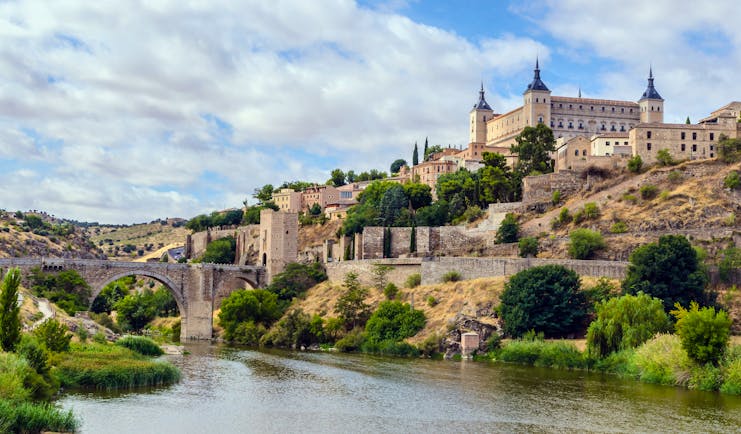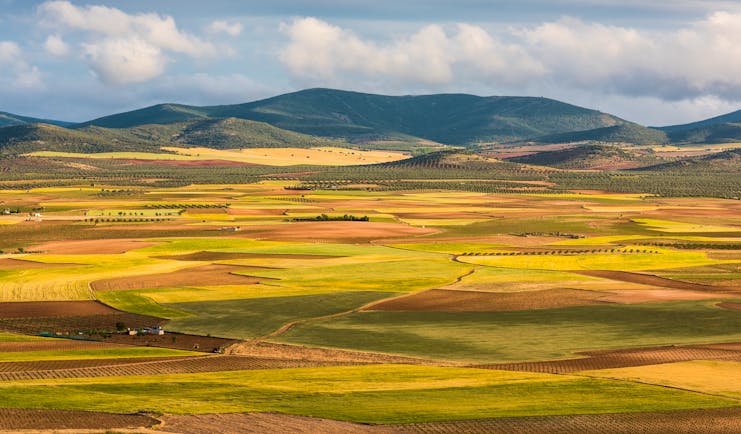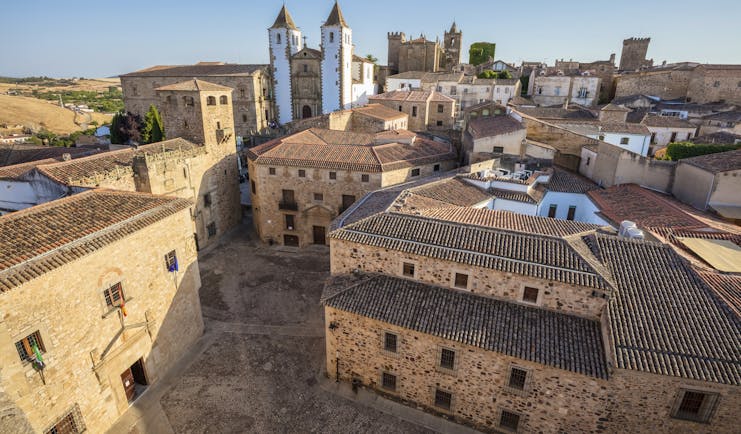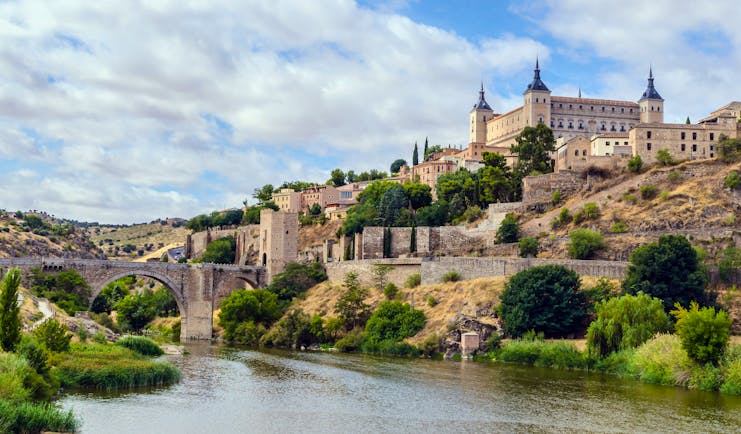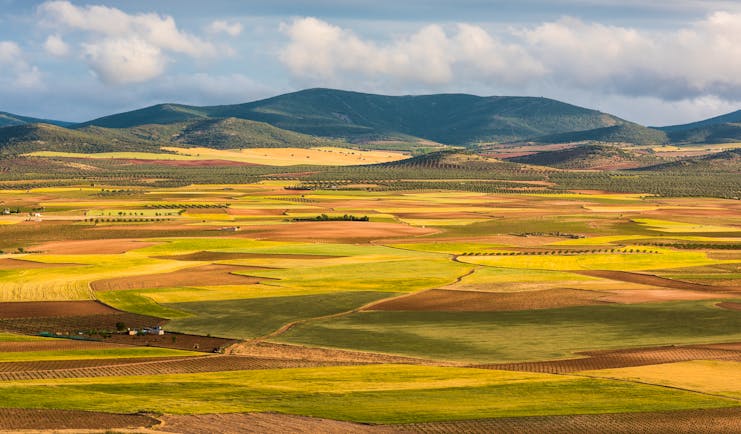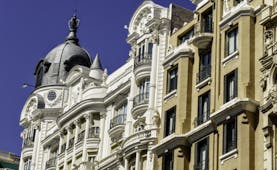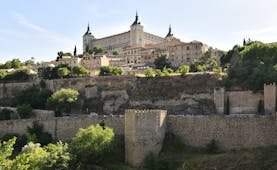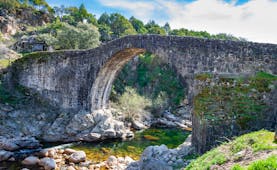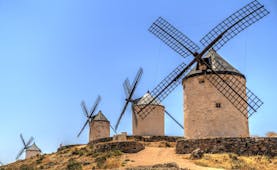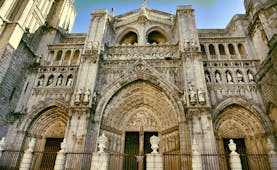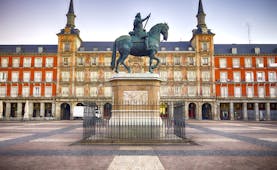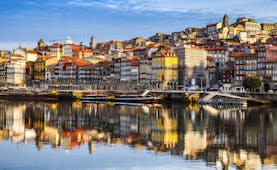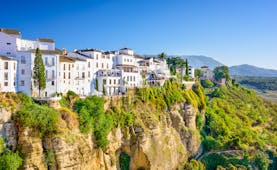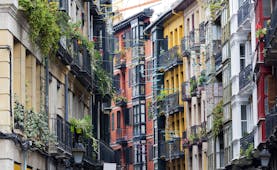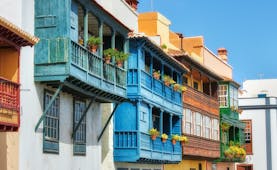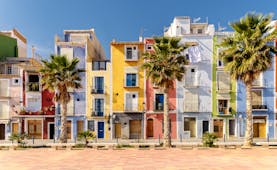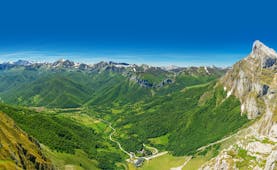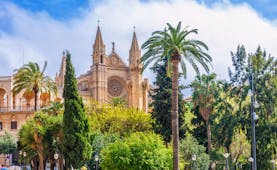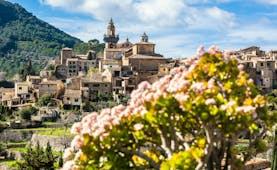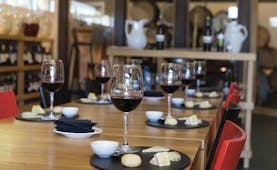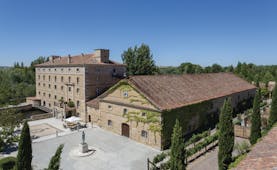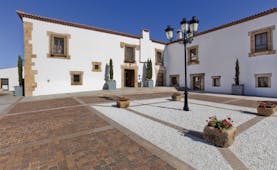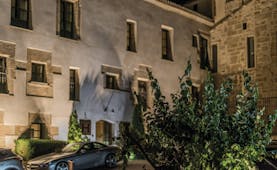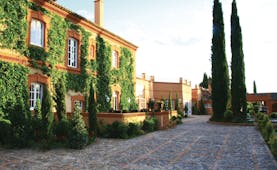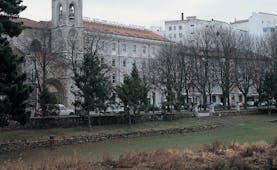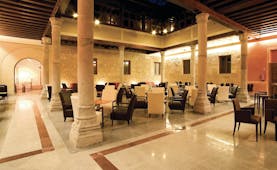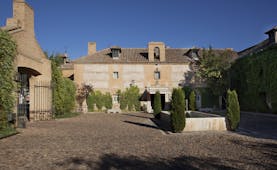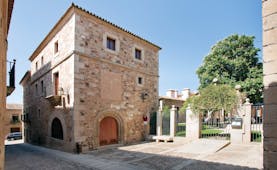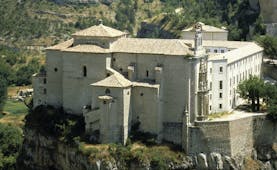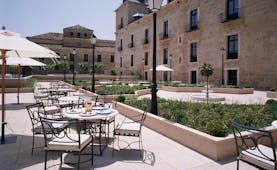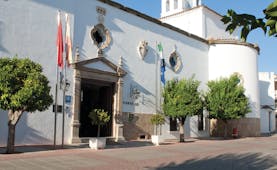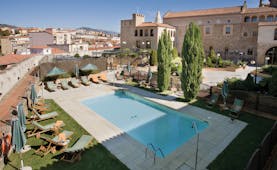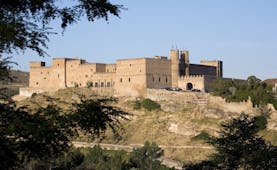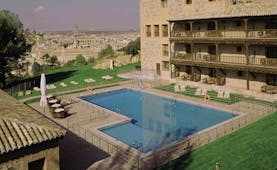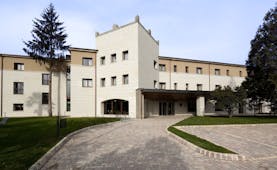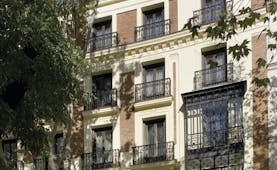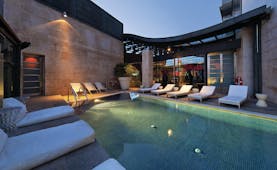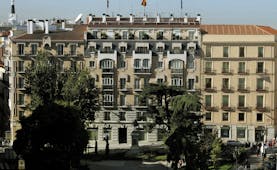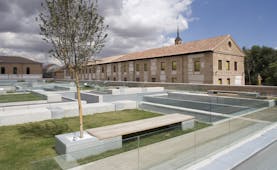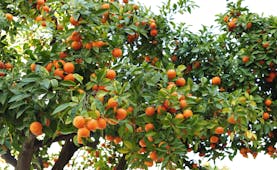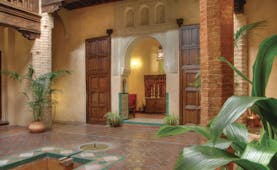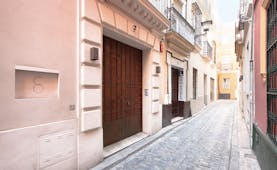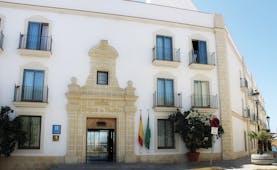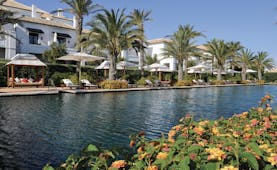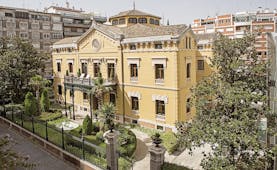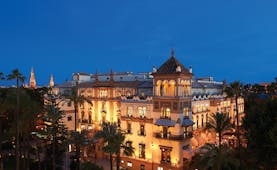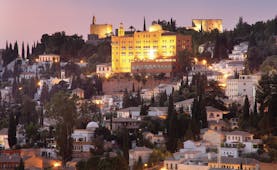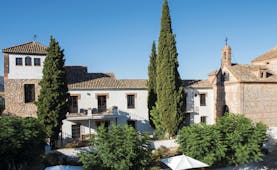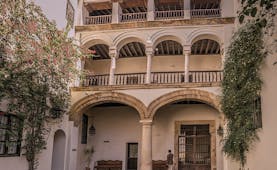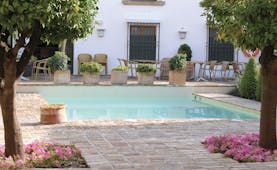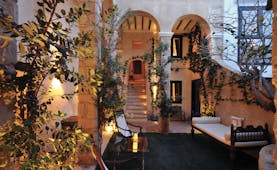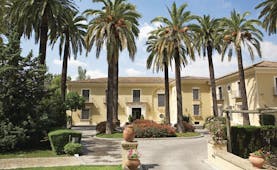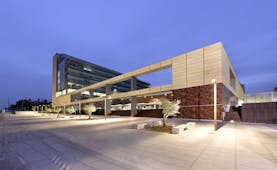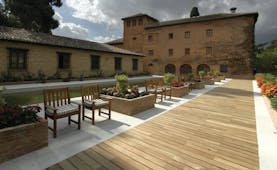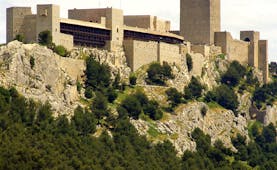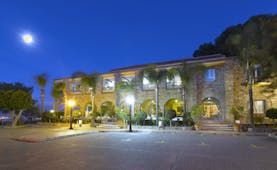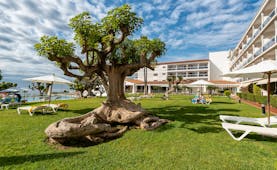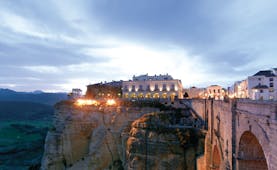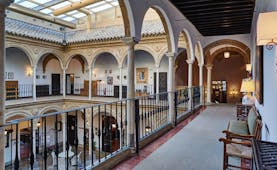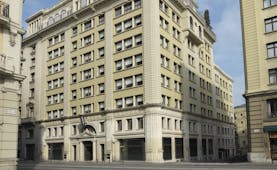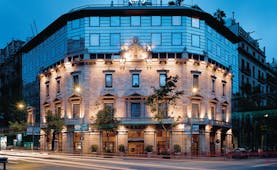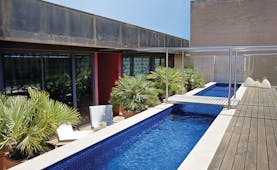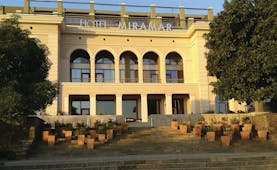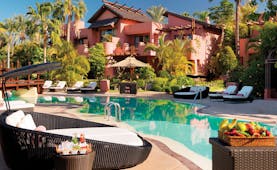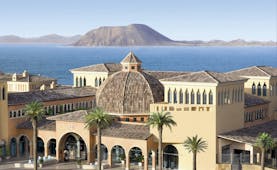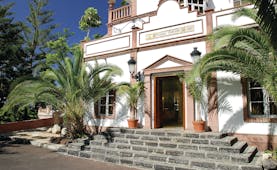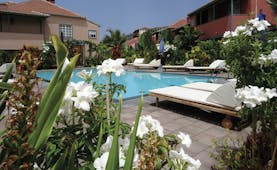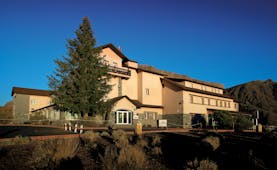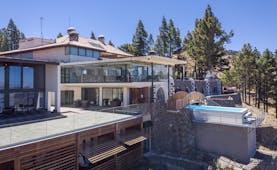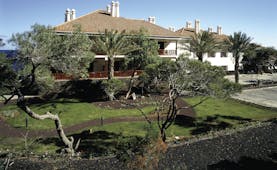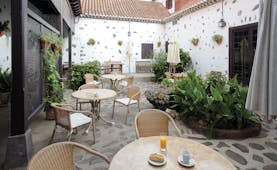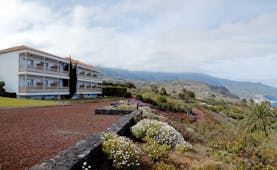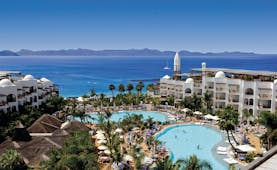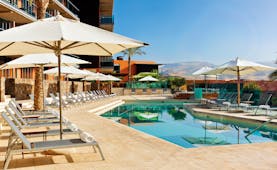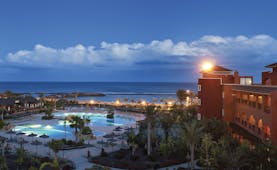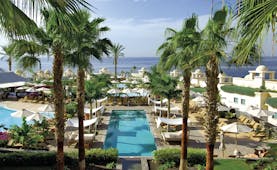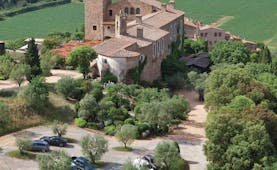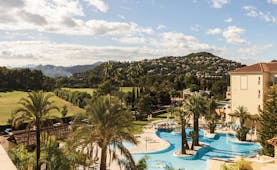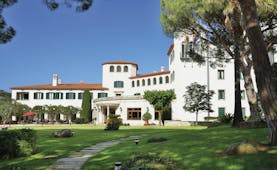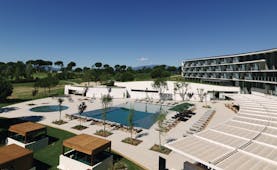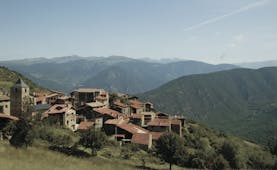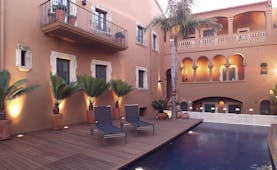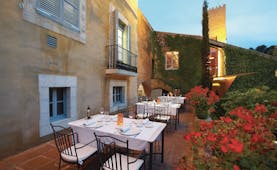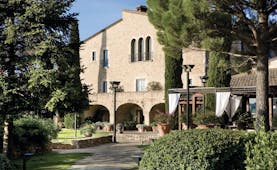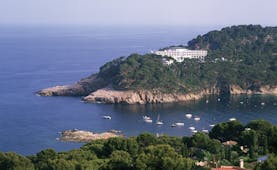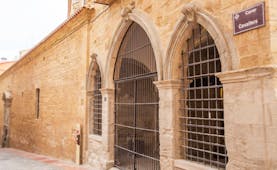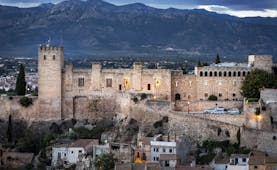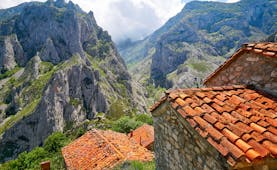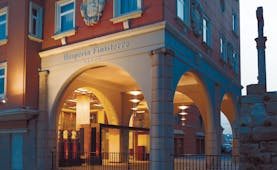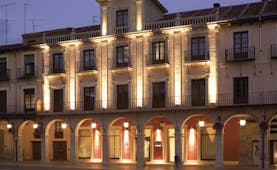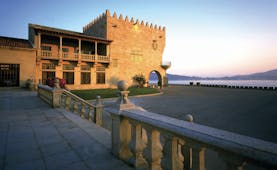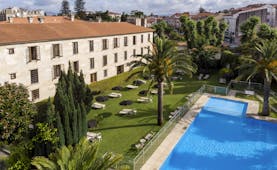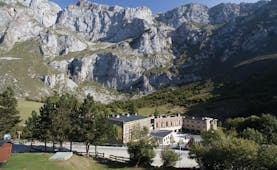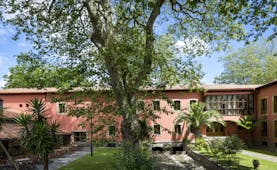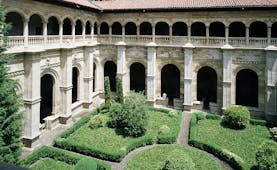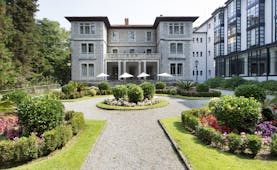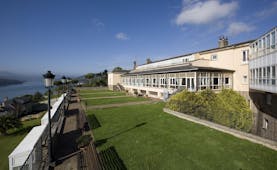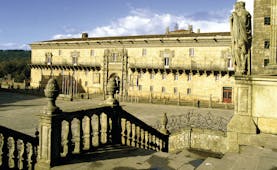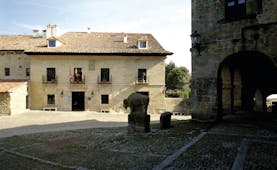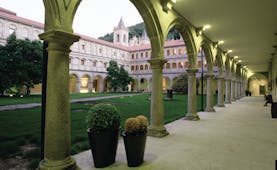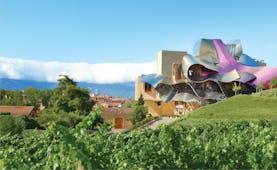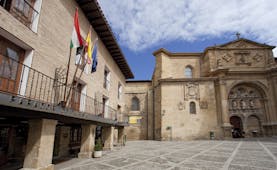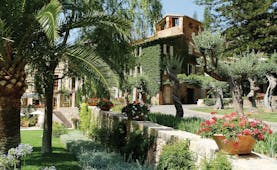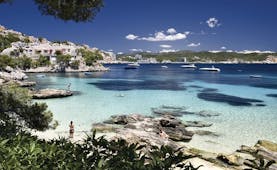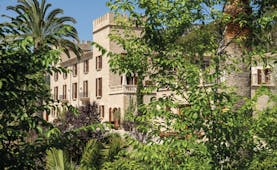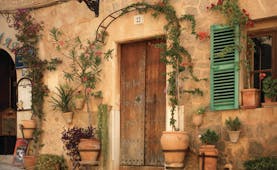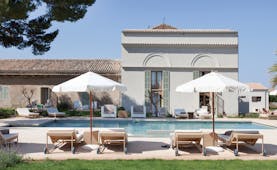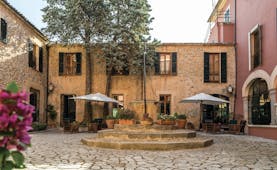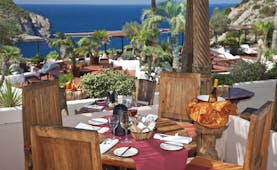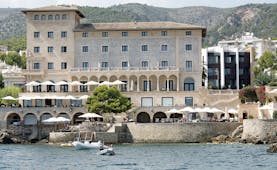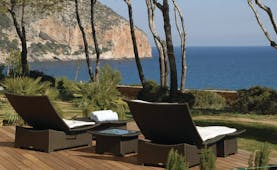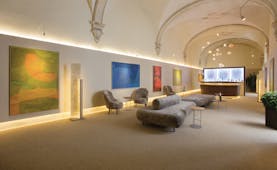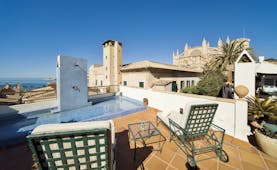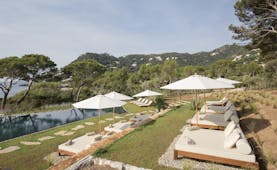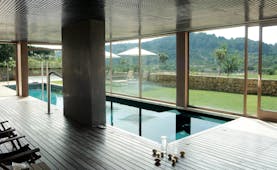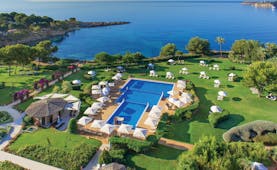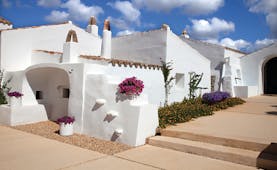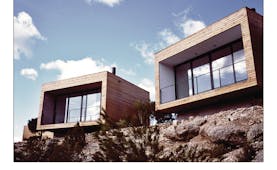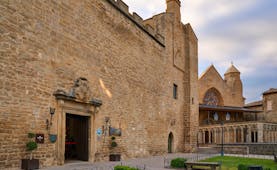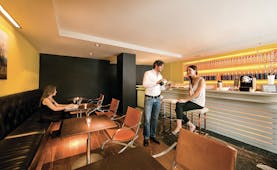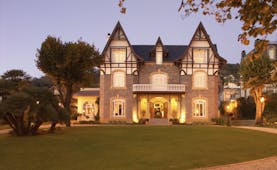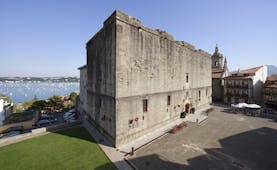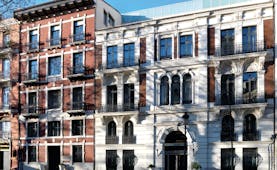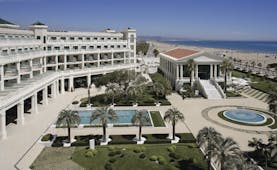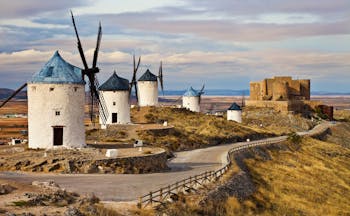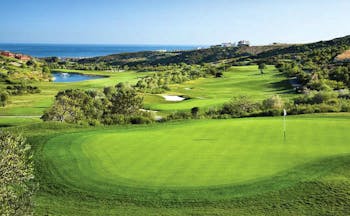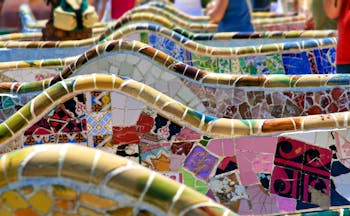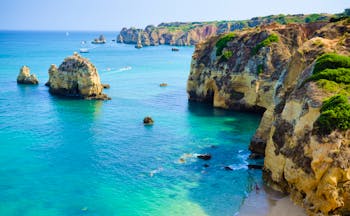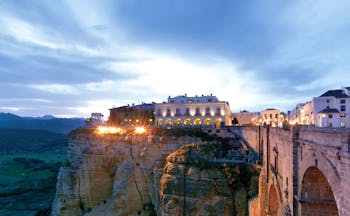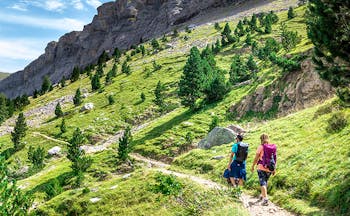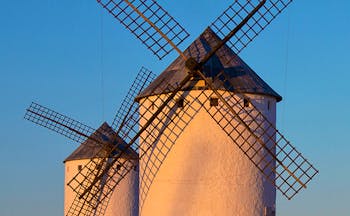Luxury touring holiday by train visiting Madrid and the heart of Spain, Castile la Mancha and Extremadura
This 12-night luxury rail touring holiday takes you from Spain’s capital city to beautiful, unspoilt destinations far off-the-beaten-track. Use the Spanish railways to make a loop of central Spain, discovering the regions of Castile la Mancha and Extremadura from the comfort of your train carriage. Your holiday starts with a flight to Madrid. Spend your time in Madrid exploring the city, perhaps visiting the Prado, Thyssen and Reina Sofia museums, the Royal Palace, cathedral and the tranquil Retiro Park. On your last day here, catch a lunchtime train south. The city melts away as the train takes you through the wide ochre plains of central Spain, passing patchworks of irrigated fields and historic towns like Aranjuez and Manzanares. You arrive at your next stop, the small city of Almagro in the mid-afternoon. The town has been declared an area of Artistic-Historic importance and the Plaza Mayor is a great place to start your exploration. This large square has cafes, interesting architecture and is also home to the 17th century Corral de Comedias – the only open-air theatre in Spain to remain intact and in operation. The direct train service from Almagro to Merida leaves in the late afternoon and winds its way eastwards across the country in the evening light. Your first stop is Ciudad Real and it is possible to take an earlier train this far in order to spend a few hours in the city before continuing to Merida. Merida is renowned for the depth of its Roman heritage, once the capital of Roman Lusitania. Navigate the quaint streets seeking out the theatre, amphitheatre, aqueduct, and other monuments, finishing off each day with a night of relaxation at the Parador de Merida, situated within a historic convent. From Merida the train takes you north to Caceres, a mediaeval town riddled with evidence of both its Moorish and Christian heritage. Use your time here to explore the ambience and fascinating architecture of Merida and perhaps take a daytrip by rail to nearby Plasencia. The train departing Caceres leaves after breakfast and takes you north to Madrid where you change onto the local service to Toledo, your last stop. Toledo is known as the City of Three Cultures, with landmarks such as the exquisite Gothic cathedral, and the Cristo de la Luz mosque. The intriguing amalgamation of such different cultures gives Toledo a unique edge and a memorable end to your tour. On your last morning, take a train back to Madrid and catch a local taxi to the airport for your flight home.
Highlights
Madrid • Almagro • Merida • Caceres • Toledo
Day by day
Start your holiday flying from the UK to Madrid. We include flights with British Airways from London Heathrow to Madrid but can offer regional options if preferred. On arrival in Madrid you will be met by a private luxury car transfer who will drive you into the city to reach your first hotel. The rest of the day is at leisure to start exploring the Spanish capital.
You have two whole days to enjoy the city. From your base in the centre of Madrid, it is a short walk to the Calle de Serrano, the city's best-known shopping street where you will find a huge number of designer boutiques. A short walk in the other direction will instead bring you to the pleasant Retiro Park, where visitors can easily while away an afternoon relaxing on the spacious stretches of shaded lawns or rowing on the boating lake. The Retiro Park belonged to the Spanish monarchy until the late 19th century and covers over 125 hectares. Here you will also find magnificent monuments and statues as well as the Velázquez Palace and Glass Palace which are exhibition halls for the Reina Sofia Museum. Nearby are the art museums which make up Madrid's Golden Triangle; the Prado, Reina Sofia and Thyssen-Bornemisza. If choosing just one, perhaps the most important of the three is the Museo del Prado which houses a definitive collection of Spanish works of art from the past 500 years including Goya, El Greco and Velázquez in particular. For those with a greater interest in history and architecture, a wander past some of the city's most famous plazas will bring you to the Royal Palace which can be reached on foot within half an hour. As you would expect from a capital city, Madrid offers a huge selection of restaurants to choose from serving classic dishes, regional Spanish cuisine and plenty of tapas. For the best quality ingredients, stick to seasonal dishes such as cocido madrileño (a typical meat and bean stew) in winter months and a light, cold soups such as gazpacho and salmorejo in the summer.
You can enjoy a relaxed breakfast and morning at your hotel since your train to Almagro doesn’t leave until lunchtime. Head to Atocha train station on the Plaza del Emperador Carlos V and board the train heading south. The buildings around you melt away as you leave the city and enter the wide-open plains of Castile la Mancha, passing patchworks of fields and farmland as well as the historic towns of Aranjuez and Manzanares. The landscape in this part of Spain is characterised by the red clay which gives an ochre tint to the scenery. This colour, almagre in Spanish, in turn names the city of Almagro where you stay next.
Almagro is a Castilian city and a declared area of Artistic-Historical Importance which offers visitors a glimpse into authentic Spanish life, far from the beaten track and honeypot cities of Andalusia. Start your visit here in the Plaza Mayor where you can find a selection of restaurants, cafes and interesting buildings including the Corral de Comedias open-air theatre. The last of its kind, this is the only open-air theatre to remain intact and has been giving performances since the early 17th century. This busy playhouse has regular performances and hosts the prestigious International Classical Theatre Festival each year. Shows are mostly in Spanish and the hotel reception can provide more information on arrival. Aside from the theatre, other sites to visit include the Old University, National Museum of Theatre, Oviedo Palace and Valanzuela City Gate. Relax at your hotel after a busy day, making the most of the tranquil gardens, interior courtyards and seasonal swimming pool. Dine in summer at the Parador’s Patio de Agua restaurant, situated in one of the convent’s courtyards surrounded by palm trees, bamboo and fountains. During the colder months, the Entrepatios restaurant provides an inside dining option. Delicious regional dishes are served with recommendations of local mines from La Mancha or Valdepeñas origins.
There is one daily direct service from Almagro to Merida which leaves in the mid-afternoon. This gives you plenty of additional time in Almagro to enjoy at the hotel before continuing your journey. The first town you reach by train is Ciudad Real and there are several earlier trains in the day to get here if you prefer to steal a few hours to look around. Ciudad Real has been forever immortalised as the setting for the misadventures of the legendary Don Quixote and visitors to the city might like to stop at the dedicated museum. This beautiful medieval city offers up ancient city walls with the original city gate, la Puerta de Toledo, and the San Pedro Church with its Gothic architecture and Moorish decorations. The local cuisine is based primarily on cheese, cured meats and wine making a stop for lunch well worth it. Continuing by rail from here, the landscape becomes greener and hills feature along the railway track as you pass through Puertollano and enter the neighbouring region of Extremadura. You pass the southern reaches of la Serena reservoir and the castles of Madroniz and Almorchón before approaching Merida as the track runs parallel to the River Guadiana. Arrive in Merida in the evening and check into your hotel, perhaps enjoying a regional meal at the hotel’s restaurant.
Explore Mérida, home to some of Spain’s finest examples of Roman architecture, and once the capital of Roman Lusitania. Begin with the 1st century theatre and amphitheatre, the former of which is built around a stage set of 2 stacked rows of columns decorated with sculptures of deities and imperial figures. The amphitheatre also retains some of its original features, including the box, gallery, and grandstands, and is still in use today. In the city centre, through the Arch of Trajan, stands the Temple of Diana. Scattered throughout the city are the ruins of Spain’s longest Roman bridges, one of which extends to over 800 metres, with 60 arches, the stony paving of an excavated Roman Street, and the Aqueduct de los Milagros, all of which establish a distinct atmosphere in this historic town. Across the river is the Alcazaba citadel, the fortress of which preserves an underground Roman reservoir, now decorated with Visigothic pilasters. The National Museum of Roman Art is the perfect stop after a day of exploring the ruins on the streets. Marvel at the excellently preserved sculptures, columns, and mosaics, all of which are housed in a striking contemporary building that, in its arches, tall halls, and Latinate marble name plate on the front, harks back to the Roman architectural structures that it honours. In the evenings, return to the Parador de Mérida to relax in the luxurious public rooms, before dining in the hotel’s restaurant on local delicacies, accompanied by Ribera del Guadiana wines. Finish off your meals in Mérida with desserts made by the expert pastry chefs. After dark, head back into the town centre to see the ruins and quaint streets lit up by atmospheric lighting.
Your train leaves from Merida about midday and you arrive in Caceres just 50 minutes later. Take a taxi from the train station to your hotel.
There is plenty of time in Cáceres to discover the authentically mediaeval old town, which appears almost unchanged since its 16th century heyday, complete with cobbled streets and a convent selling traditional candied egg yolks. With an extremely high concentration of historic buildings, Cáceres’ prosperous history is evident in its Renaissance palaces, ancestral houses, towers, and plazas, many of which date from the 15th and 16th centuries. The history of battles between the Moors and the Christians has left its mark on these mediaeval streets, which are now a blend of Roman, Islamic, Gothic, and Italian Renaissance styles. There are over 30 Islamic towers, though the most famous is the Torre del Bujaco, a 12th century tower that overlooks the pretty Plaza Mayor. The Concatedral de Santa María, situated on a plaza of the same name, dates from the 15th century. Its imposing austere façade gives way to a luminous interior, with a brilliantly carved cedar altarpiece as the centre point. This impressive building now houses several noble tombs, an ecclesiastical museum, a series of chapels, and a bell tower which offers fantastic views over the Old Town. The Roman heritage of the town can be seen in the Arco del Cristo, a Roman gate that links two sloping streets together. On the Plaza de San Jorge stands the Iglesia de San Francisco Javier, an 18th century Jesuit Church. Though a more modern addition to the town, its white towers have become somewhat iconic; inside, its golden altar, in contrast with its bright white walls, is mesmerising. The pathways and sights in Cáceres are incredibly rewarding and varied, crossing bridges, and climbing small hills, passing buildings that mix the typically Spanish white-washed houses with those of warm stone. The best times to enjoy the magnificent city that lies within these mediaeval walls are either on a quiet day, or in the evening. At these times, the peaceful beauty of the place can be enjoyed, as well as the horizon sculpted by the roofs and sculptures of Cáceres’ religious and historic buildings. During your stay in Caceres you might also like to use the train to visit nearby Plasencia for a day trip. The journey time is around one hour each way, making it easy to explore the riverside town, famed for its weekly market dating back to the 12th century, as well as its two cathedrals, towering above the town, which are back-to-back. The Old Cathedral was built in the 13th century, in-keeping with the Romanesque style which had only just reached Plasencia due to its position on the Christian and Muslim border. The New Cathedral was built in the 16th century with Gothic, Renaissance, and Plateresque elements on both the interior and exterior designs. The Cathedral Museum nearby houses some of the greatest artworks that have been on display in the cathedral, from the Gothic panel of the Caná Wedding, to the works of Baroque painters such as Gregorio Fernández and the Brothers Churriguera.
Have an early breakfast at your hotel to take the 9am train to Madrid. This direct train takes you north from Caceres, past the Jose María Oriol reservoir which is fed by the River Tagus. The track then turns westwards skirting Monfrague National Park and crosses back into Castile la Mancha. Pass through the central city of Talavera de la Reina, known for its beautiful ceramics which adorn the Basilica de Nuestra Senora del Prado and arrive in Madrid Atocha station around midday. Change platforms here and pick up the direct service to Toledo where you arrive about 30 minutes later. Take a taxi to your hotel in the city centre.
Best visited mid-week to avoid the crowds, Toledo is known as the City of Three Cultures due to the co-existence of Christianity, Islam and Judaism. Built into a wide meander of the River Tajo, this spectacular city combines the spires of its Gothic cathedral, and the domes and archways of synagogues and mosques, with the impressive landscape of central Spain. Toledo was made famous by El Greco, a Greek painter who made the city his home in the 16th century. The 13th century Gothic cathedral, the crowning glory of the town centre, was built on the site of a Muslim mosque and now houses a rich collection of paintings by the likes of Rubens, Raphael, and Titian, in the Sanctuary. Enter this formidable building through the Puerta de Mollete, from which food was once distributed to the poorer residents. Inside, 88 columns support the vaulted roof, and some of the stained-glass windows date back to the 13th century. Admire the craftsmanship of the marble tombs in the Capilla de Santiago, and the artistry of the Retablo of the New Testament in the Capilla Mayor. For a taste of the exotic, perhaps move on to the Cristo de la Luz, decorated with keyhole archways and colourful stone. The Iglesia de Santiago de Arrabal is the most stunning example of Mudéjar architecture in the city, constructed out of dark brick, with curved, indented walls. The Puerta Vieja de Bisagra is the only remaining section of the Moorish town walls, and the Iglesia de Santo Tomé resembles the minarets of Marrakech. The Alcázar of Toledo sits at the highest point of the city, overlooking both the river and the bustling streets. Now, this 16th century palace houses a military museum, which sheds valuable light on Spanish military history. These are just a few of the eclectic architectural and historical delights that Toledo has to offer, and a few hours wandering around the city are sure to throw up infinite treasures, including the baths and caves. Do not miss out on the local products sold in the many small shops tucked away on the side streets; admire the damascene metalwork and indulge in the Toledo marzipan.
There are regular trains between Toledo and Madrid and your Personal Travel Specialist will select one to work with your flight back to the UK. A short train journey brings you back to Madrid Atocha station from where you take a taxi to the airport.
It has been a lovely holiday & once again, you did not disappoint. Thank you again for everything. We look forward to contacting you again for our next adventure.Mrs H, July 2025
Holiday price guide Prices from £2,530 per person based on two people sharing a double or twin room.
Holiday Code SNFR08
Call us on 01392 441245
Luxury touring holiday by train visiting Madrid and the heart of Spain, Castile la Mancha and Extremadura
Start your holiday flying from the UK to Madrid. We include flights with British Airways from London Heathrow to Madrid but can offer regional options if preferred. On arrival in Madrid you will be met by a private luxury car transfer who will drive you into the city to reach your first hotel. The rest of the day is at leisure to start exploring the Spanish capital.
You have two whole days to enjoy the city. From your base in the centre of Madrid, it is a short walk to the Calle de Serrano, the city's best-known shopping street where you will find a huge number of designer boutiques. A short walk in the other direction will instead bring you to the pleasant Retiro Park, where visitors can easily while away an afternoon relaxing on the spacious stretches of shaded lawns or rowing on the boating lake. The Retiro Park belonged to the Spanish monarchy until the late 19th century and covers over 125 hectares. Here you will also find magnificent monuments and statues as well as the Velázquez Palace and Glass Palace which are exhibition halls for the Reina Sofia Museum. Nearby are the art museums which make up Madrid's Golden Triangle; the Prado, Reina Sofia and Thyssen-Bornemisza. If choosing just one, perhaps the most important of the three is the Museo del Prado which houses a definitive collection of Spanish works of art from the past 500 years including Goya, El Greco and Velázquez in particular. For those with a greater interest in history and architecture, a wander past some of the city's most famous plazas will bring you to the Royal Palace which can be reached on foot within half an hour. As you would expect from a capital city, Madrid offers a huge selection of restaurants to choose from serving classic dishes, regional Spanish cuisine and plenty of tapas. For the best quality ingredients, stick to seasonal dishes such as cocido madrileño (a typical meat and bean stew) in winter months and a light, cold soups such as gazpacho and salmorejo in the summer.
You can enjoy a relaxed breakfast and morning at your hotel since your train to Almagro doesn’t leave until lunchtime. Head to Atocha train station on the Plaza del Emperador Carlos V and board the train heading south. The buildings around you melt away as you leave the city and enter the wide-open plains of Castile la Mancha, passing patchworks of fields and farmland as well as the historic towns of Aranjuez and Manzanares. The landscape in this part of Spain is characterised by the red clay which gives an ochre tint to the scenery. This colour, almagre in Spanish, in turn names the city of Almagro where you stay next.
Almagro is a Castilian city and a declared area of Artistic-Historical Importance which offers visitors a glimpse into authentic Spanish life, far from the beaten track and honeypot cities of Andalusia. Start your visit here in the Plaza Mayor where you can find a selection of restaurants, cafes and interesting buildings including the Corral de Comedias open-air theatre. The last of its kind, this is the only open-air theatre to remain intact and has been giving performances since the early 17th century. This busy playhouse has regular performances and hosts the prestigious International Classical Theatre Festival each year. Shows are mostly in Spanish and the hotel reception can provide more information on arrival. Aside from the theatre, other sites to visit include the Old University, National Museum of Theatre, Oviedo Palace and Valanzuela City Gate. Relax at your hotel after a busy day, making the most of the tranquil gardens, interior courtyards and seasonal swimming pool. Dine in summer at the Parador’s Patio de Agua restaurant, situated in one of the convent’s courtyards surrounded by palm trees, bamboo and fountains. During the colder months, the Entrepatios restaurant provides an inside dining option. Delicious regional dishes are served with recommendations of local mines from La Mancha or Valdepeñas origins.
There is one daily direct service from Almagro to Merida which leaves in the mid-afternoon. This gives you plenty of additional time in Almagro to enjoy at the hotel before continuing your journey. The first town you reach by train is Ciudad Real and there are several earlier trains in the day to get here if you prefer to steal a few hours to look around. Ciudad Real has been forever immortalised as the setting for the misadventures of the legendary Don Quixote and visitors to the city might like to stop at the dedicated museum. This beautiful medieval city offers up ancient city walls with the original city gate, la Puerta de Toledo, and the San Pedro Church with its Gothic architecture and Moorish decorations. The local cuisine is based primarily on cheese, cured meats and wine making a stop for lunch well worth it. Continuing by rail from here, the landscape becomes greener and hills feature along the railway track as you pass through Puertollano and enter the neighbouring region of Extremadura. You pass the southern reaches of la Serena reservoir and the castles of Madroniz and Almorchón before approaching Merida as the track runs parallel to the River Guadiana. Arrive in Merida in the evening and check into your hotel, perhaps enjoying a regional meal at the hotel’s restaurant.
Explore Mérida, home to some of Spain’s finest examples of Roman architecture, and once the capital of Roman Lusitania. Begin with the 1st century theatre and amphitheatre, the former of which is built around a stage set of 2 stacked rows of columns decorated with sculptures of deities and imperial figures. The amphitheatre also retains some of its original features, including the box, gallery, and grandstands, and is still in use today. In the city centre, through the Arch of Trajan, stands the Temple of Diana. Scattered throughout the city are the ruins of Spain’s longest Roman bridges, one of which extends to over 800 metres, with 60 arches, the stony paving of an excavated Roman Street, and the Aqueduct de los Milagros, all of which establish a distinct atmosphere in this historic town. Across the river is the Alcazaba citadel, the fortress of which preserves an underground Roman reservoir, now decorated with Visigothic pilasters. The National Museum of Roman Art is the perfect stop after a day of exploring the ruins on the streets. Marvel at the excellently preserved sculptures, columns, and mosaics, all of which are housed in a striking contemporary building that, in its arches, tall halls, and Latinate marble name plate on the front, harks back to the Roman architectural structures that it honours. In the evenings, return to the Parador de Mérida to relax in the luxurious public rooms, before dining in the hotel’s restaurant on local delicacies, accompanied by Ribera del Guadiana wines. Finish off your meals in Mérida with desserts made by the expert pastry chefs. After dark, head back into the town centre to see the ruins and quaint streets lit up by atmospheric lighting.
Your train leaves from Merida about midday and you arrive in Caceres just 50 minutes later. Take a taxi from the train station to your hotel.
There is plenty of time in Cáceres to discover the authentically mediaeval old town, which appears almost unchanged since its 16th century heyday, complete with cobbled streets and a convent selling traditional candied egg yolks. With an extremely high concentration of historic buildings, Cáceres’ prosperous history is evident in its Renaissance palaces, ancestral houses, towers, and plazas, many of which date from the 15th and 16th centuries. The history of battles between the Moors and the Christians has left its mark on these mediaeval streets, which are now a blend of Roman, Islamic, Gothic, and Italian Renaissance styles. There are over 30 Islamic towers, though the most famous is the Torre del Bujaco, a 12th century tower that overlooks the pretty Plaza Mayor. The Concatedral de Santa María, situated on a plaza of the same name, dates from the 15th century. Its imposing austere façade gives way to a luminous interior, with a brilliantly carved cedar altarpiece as the centre point. This impressive building now houses several noble tombs, an ecclesiastical museum, a series of chapels, and a bell tower which offers fantastic views over the Old Town. The Roman heritage of the town can be seen in the Arco del Cristo, a Roman gate that links two sloping streets together. On the Plaza de San Jorge stands the Iglesia de San Francisco Javier, an 18th century Jesuit Church. Though a more modern addition to the town, its white towers have become somewhat iconic; inside, its golden altar, in contrast with its bright white walls, is mesmerising. The pathways and sights in Cáceres are incredibly rewarding and varied, crossing bridges, and climbing small hills, passing buildings that mix the typically Spanish white-washed houses with those of warm stone. The best times to enjoy the magnificent city that lies within these mediaeval walls are either on a quiet day, or in the evening. At these times, the peaceful beauty of the place can be enjoyed, as well as the horizon sculpted by the roofs and sculptures of Cáceres’ religious and historic buildings. During your stay in Caceres you might also like to use the train to visit nearby Plasencia for a day trip. The journey time is around one hour each way, making it easy to explore the riverside town, famed for its weekly market dating back to the 12th century, as well as its two cathedrals, towering above the town, which are back-to-back. The Old Cathedral was built in the 13th century, in-keeping with the Romanesque style which had only just reached Plasencia due to its position on the Christian and Muslim border. The New Cathedral was built in the 16th century with Gothic, Renaissance, and Plateresque elements on both the interior and exterior designs. The Cathedral Museum nearby houses some of the greatest artworks that have been on display in the cathedral, from the Gothic panel of the Caná Wedding, to the works of Baroque painters such as Gregorio Fernández and the Brothers Churriguera.
Have an early breakfast at your hotel to take the 9am train to Madrid. This direct train takes you north from Caceres, past the Jose María Oriol reservoir which is fed by the River Tagus. The track then turns westwards skirting Monfrague National Park and crosses back into Castile la Mancha. Pass through the central city of Talavera de la Reina, known for its beautiful ceramics which adorn the Basilica de Nuestra Senora del Prado and arrive in Madrid Atocha station around midday. Change platforms here and pick up the direct service to Toledo where you arrive about 30 minutes later. Take a taxi to your hotel in the city centre.
Best visited mid-week to avoid the crowds, Toledo is known as the City of Three Cultures due to the co-existence of Christianity, Islam and Judaism. Built into a wide meander of the River Tajo, this spectacular city combines the spires of its Gothic cathedral, and the domes and archways of synagogues and mosques, with the impressive landscape of central Spain. Toledo was made famous by El Greco, a Greek painter who made the city his home in the 16th century. The 13th century Gothic cathedral, the crowning glory of the town centre, was built on the site of a Muslim mosque and now houses a rich collection of paintings by the likes of Rubens, Raphael, and Titian, in the Sanctuary. Enter this formidable building through the Puerta de Mollete, from which food was once distributed to the poorer residents. Inside, 88 columns support the vaulted roof, and some of the stained-glass windows date back to the 13th century. Admire the craftsmanship of the marble tombs in the Capilla de Santiago, and the artistry of the Retablo of the New Testament in the Capilla Mayor. For a taste of the exotic, perhaps move on to the Cristo de la Luz, decorated with keyhole archways and colourful stone. The Iglesia de Santiago de Arrabal is the most stunning example of Mudéjar architecture in the city, constructed out of dark brick, with curved, indented walls. The Puerta Vieja de Bisagra is the only remaining section of the Moorish town walls, and the Iglesia de Santo Tomé resembles the minarets of Marrakech. The Alcázar of Toledo sits at the highest point of the city, overlooking both the river and the bustling streets. Now, this 16th century palace houses a military museum, which sheds valuable light on Spanish military history. These are just a few of the eclectic architectural and historical delights that Toledo has to offer, and a few hours wandering around the city are sure to throw up infinite treasures, including the baths and caves. Do not miss out on the local products sold in the many small shops tucked away on the side streets; admire the damascene metalwork and indulge in the Toledo marzipan.
There are regular trains between Toledo and Madrid and your Personal Travel Specialist will select one to work with your flight back to the UK. A short train journey brings you back to Madrid Atocha station from where you take a taxi to the airport.
It has been a lovely holiday & once again, you did not disappoint. Thank you again for everything. We look forward to contacting you again for our next adventure.Mrs H, July 2025
Holiday price guide Prices from £2,530 per person based on two people sharing a double or twin room.
Holiday Code SNFR08
Our prices include
● Scheduled return flights with British Airways from London to Madrid
● Airport transfer on arrival in Madrid
● Standard class rail travel
● 3 nights’ bed and breakfast in a dreamer double room at the Hospes Puerta de Alcala in Madrid
● 2 nights’ bed and breakfast in a standard double room at the Parador de Almagro in Almagro
● 2 nights’ bed and breakfast in a standard double room at the Parador de Merida in Merida
● 3 nights’ bed and breakfast in a dreamer double room at the Hospes Palacio de Arenales in Caceres
● 2 nights’ bed and breakfast in a standard double room at the Parador de Toledo in Toledo
● Concierge service and Expressions Holidays regional helpful hints
Our prices do not include
● Early check-in or late check-out at any hotels (although we can arrange this on request at additional cost)
● Any other services not mentioned above, such as additional transfers and meals except breakfast at hotels
● Personal holiday insurance. This is essential and cover should be in place from when you book the holiday.
● Local tourist tax, usually between Euros 1 and 3 per person per night, and payable locally to the hotel
Additional information
Travel times for this rail holiday
Madrid to Almagro 2 hours 25 minutes
Almagro to Merida 4 hours 30 minutes
Merida to Caceres 50 minutes
Caceres to Toledo (via Madrid) 4 hours 30 minutes
Toledo to Madrid 30 minutes
Call us on 01392 441245
Luxury touring holiday by train visiting Madrid and the heart of Spain, Castile la Mancha and Extremadura

Hospes Puerta de Alcalá is a luxury 5-star boutique hotel in an excellent central location. Gastronomic delights and excellent spa facilities make this an ideal spot to recuperate after enjoying the cultural and historical sites of Madrid.

The Parador de Almagro is an historic 4-star hotel in the converted 16th century Convent of San Francisco. It is a peaceful location with seasonal outdoor pool and traditional restaurant within walking distance of the town centre.
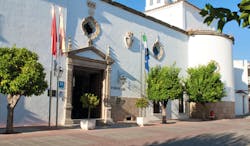
Parador de Merida is a 4-star boutique hotel offering a tranquil, historical break near Merida's Roman Ruins. Grand interiors and immaculate outdoor spaces ensure that this is a relaxing retreat from which to explore the city and the outer region.

Parador de Cáceres is a 4-star historic, boutique hotel in an excellent central location. With a melting pot of architectural features throughout the hotel building, the historic and the modern combine to create a luxurious residence and a comforting atmosphere.
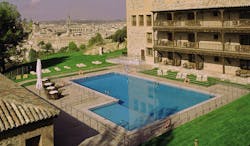
Parador de Toledo is a 4-star historical hotel in a beautiful location overlooking Toledo. The comfort and luxury of this hotel and its delicious local cuisine is ideal after a day's exploration of the historic city.
It has been a lovely holiday & once again, you did not disappoint. Thank you again for everything. We look forward to contacting you again for our next adventure.Mrs H, July 2025
Holiday price guide Prices from £2,530 per person based on two people sharing a double or twin room.
Holiday Code SNFR08
Call us on 01392 441245
Luxury touring holiday by train visiting Madrid and the heart of Spain, Castile la Mancha and Extremadura
About Heart of Spain
An Expressions tailor-made holiday to the Heart of Spain feature some of the best four and five star hotels in central Spain, featuring vineyard hotels, rural estates and city properties. Located at the geographical heart of Spain is its vibrant capital, Madrid, where days can be filled with art galleries and atmospheric outdoor cafes, and evenings promise an energetic nightlife. Surrounding the city are the dry plains of the country's central plateau which are divided by spectacular mountain ranges and dotted with numerous castles, magnificent cathedrals and ancient Roman ruins. The regions which make up Spain's central plateau have all played a hugely important role in the history of modern Spain, which is evident in the numerous castles which were built to protect towns and villages as the Moors fought the Christians in the 10th and 11th centuries. These are some of the least visited parts of Spain where few tourists venture outside of the main cities, ensuring that visitors will leave feeling like they have discovered something new. At the centre of Spain is Madrid, where atmospheric cobbled streets link bustling squares which are filled with pavement cafes and flea markets, whilst tree-line boulevards are overlooked by neo-classical buildings. Surrounding the city are the dry plains of the country's central plateau which are divided by spectacular mountain ranges and dotted with numerous castles, magnificent cathedrals and ancient Roman ruins. To the north of Madrid is Castilla y León, an elevated region which has played a hugely important role in the history of modern Spain. Rolling countryside is littered with historic cities, isolated villages and mediaeval castles, built by the Christians to defend against the Moorish invaders. Salamanca, Avila, Segovia, León, Valladolid and Burgos are all home to a wealth of art and stunning architecture, including Gothic cathedrals and Roman structures. Away from the cities are natural attractions including mountain ranges and nature reserves, with wheat fields and vineyards covering the high plateaus. To the south and east of Madrid is Castilla-La Mancha, an expansive region with dry plains stretching towards mountains in the distance. The predominantly flat scenery is made up of olive groves, wheat fields, extensive vineyards, hilltop castles and the iconic windmills described by Cervantes. Head to the historic city of Toledo, where Christian, Jewish and Arab cultures blend to create a popular tourist destination, or to Cuenca, a dramatic town where houses seemingly dangle over a plunging gorge. Further west towards the border with Portugal is Extremadura, a region with green pastures and rolling hills, forests and fertile river valleys, as well as charming towns boasting stunning examples of Roman architecture. Elaborate palaces and manor houses are found in clusters throughout the region, built by conquistadors with gold from the New World.
Highlights of the Heart of Spain
The three world-class art galleries which make up Madrid's Golden Triangle of Art, home to works by Pablo Picasso, Salvador Dalí and Francisco de Goya. The historical sights of Old Madrid, including the lavish Royal Palace, the grand Plaza Mayor and the city's spiritual centre, Puerta del Sol. Parque del Retiro, a popular spot for relaxation in the centre of Madrid with a boating lake. El Escorial, a large royal residence just outside Madrid which also functions as a monastery and is where many Spanish monarchs are buried. The Gothic cathedrals of León, Burgos and Toledo which feature stunning stained glass, mediaeval art and elaborate sculptures. The numerous castles which are scattered across the region including the Gothic-style Belmonte Castle, the Mudejár Coca Castle and the Moorish Alcazaba of Badajoz. The university city of Alcalá de Henares, birthplace of Cervantes, the 16th century author who wrote about the adventures of Don Quixote. The walled city of Ávila. The university city of Salamanca. Segovia, with its Roman Aqueduct and distinctive castle. Cuenca, a picturesque old town with houses which appear to hang over a gorge. The iconic windmills which sit on the plains near Consuegra. Roman ruins in Mérida. Elaborate palaces and manor houses in Trujillo and Cáceres. The wine-producing regions throughout central Spain including Ribera del Duero, La Mancha and Valdepeñas where visitors can visit vineyards and enjoy wine tastings. Mountain ranges which divide the central plateau, with many opportunities for walking and rock climbing.
Festivals in the Heart of Spain
February: Caja Madrid Flamenco Festival, February to March: Madrid Carnival, February to March: Madrid Contemporary Art Fair, March/April: Holy week celebrations, May: San Isidro bullfighting festival (Madrid), May/June: Toledo Corpus Christi processions (Toledo), July to August: Madrid summer arts festival, October: Saffron Rose Festival (Consuegra), October: Cervantes Week (Alcala de Henares), October to November: Madrid Autumn Festival
Gastronomy in the Heart of Spain
As expected, Madrid is home to some excellent restaurants serving a great range of cuisine from throughout Spain and around the world. Roasted meat and game as well as a variety of broths and stews are common features on menus throughout central Spain, where traditional cooking is simple and hearty. Cuisine varies slightly between the regions, with more paprika and saffron being used in the south. Various pulses are grown on the plains of Castilla y León, whilst Manchego cheese produced in La Mancha and high quality Ibérico ham is produced in Extremadura. There are a number of wine regions which produce high-quality red and white wines. Local dishes include ‘Pollo a lo Padre Pero’ (chicken with a spicy sauce), ‘El frite’ (fried lamb), ‘Sopa de ajo’ (garlic soup), ‘Pisto manchego’ (similar to ratatouille), ‘Yemas’ (a rich dessert made with egg yolks).
Climate in the Heart of Spain
The climate of central Spain is generally quite extreme, with extremely hot summers and bitterly cold yet dry winters. Rainfall is generally quite low thanks to the mountains which surround the region. Madrid can be almost unbearable in the summer months as temperatures reach 40 degrees, whilst during the temperatures regularly drop below freezing. Spring and autumn are the best times to visit as temperatures are warm and pleasant, although there is increased rainfall.
Call us on 01392 441245
Luxury touring holiday by train visiting Madrid and the heart of Spain, Castile la Mancha and Extremadura
About Madrid
An Expressions tailor-made holiday to Madrid is a chance to explore this lively and passionate capital city with a laid-back lifestyle. Atmospheric cobbled streets link bustling squares which are filled with pavement cafes, whilst tree-lined boulevards are overlooked by neo-classical buildings. Our luxury holidays to Madrid feature some of the best four- and five-star hotels in the city, including elegant hotels and more boutique properties. Visitors to Madrid will find plenty to fill their days. Art and culture play an important role, primarily thanks to the three world-class art museums which make up Madrid’s Golden Triangle of Art, home to works by Pablo Picasso, Salvador Dalí and Francisco de Goya. Illustrating the city’s rich history are the sights of Old Madrid, including the lavish Royal Palace, the grand Plaza Mayor, and the city’s spiritual centre – Puerta del Sol. There are plenty of designer shops to browse throughout the city, as well as small boutiques and flea markets which visitors might stumble across. It is after dark that Madrid really comes alive as the streets, parks and open-air cafes fill with people of all ages and the bars and clubs remain open until dawn. What better way to recover from a late night than to while away a morning in the Parque del Retiro, strolling through the beautiful gardens and perhaps hiring a rowing boat on the park’s tranquil lake. For those who wish to escape the energetic city, a number of towns are located nearby which make for an interesting day trip.
Highlights of Madrid
Numerous squares including the historic Plaza Mayor, the setting of bullfights and executions during the Spanish Inquisition. The Royal Palace, a lavish building which was constructed in the 1700s and is still used today for state occasions. The Prado Museum, one of the largest art galleries in the world which contains an impressive selection of Spanish paintings including works by Goya and El Greco. Reina Sofia Museum, displaying modern works including Picasso’s ‘Guernica’. Thyssen-Bornemisza Museum, based on a private art collection which illustrates the history of western art and includes pieces by Goya, Degas and Renoir. Retiro Park formerly used by the royal family and now a popular spot for relaxation. The Teatro Real, an important opera house with performances of opera and dance. Almudena Cathedral. Gran Vía, a famous street which is lined by theatres and shops. Debod Temple, an ancient Egyptian temple which was rebuilt in Madrid in the 1960s. The Santiago Bernabéu Football stadium, home to Real Madrid. El Rastro Market, an open-air flea market which is held on Sundays. Ventas Bullring where bullfights take place every week during the bullfighting season.

